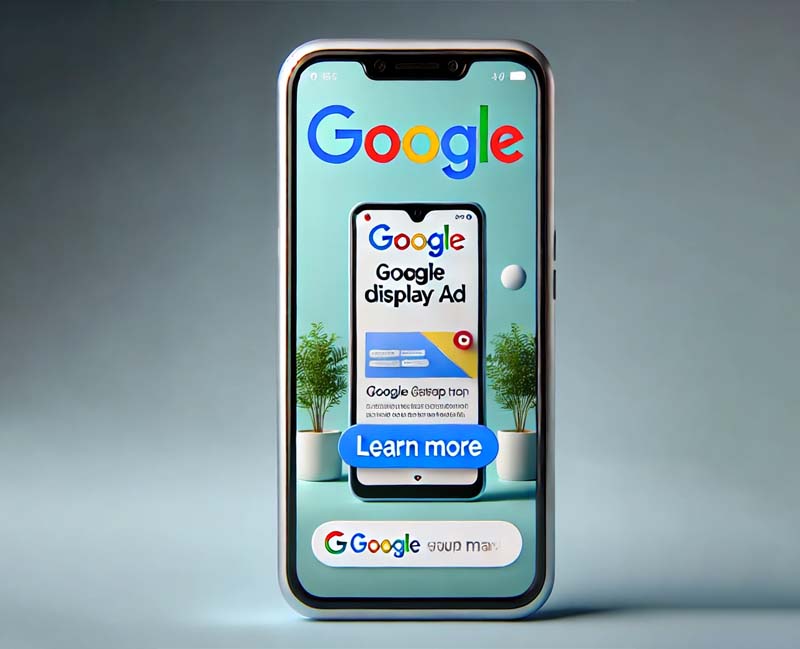- dmagencybd24@gmail.com
- 56-57, Sharif Mansion, 7th Floor, Motijheel, Dhaka- 1000
Google Display Ads

Everything You Need to Know About Google Display Ads: A Comprehensive Guide
In today’s digital age, businesses must leverage multiple channels to engage with potential customers. One powerful tool in digital advertising is Google Display Ads, which can help brands increase their visibility, drive traffic, and boost conversions. This blog will explore Google Display Ads in detail, covering what they are, how they work, and best practices for running successful display ad campaigns.
What Are Google Display Ads?
Google Display Ads are a type of advertising on the Google Display Network (GDN), a network of over 2 million websites, apps, and videos where advertisers can display their ads. Unlike Google Search Ads, which appear when someone actively searches for a specific keyword, Display Ads are shown to users while they’re browsing websites, watching videos, or using apps. The ads can be in the form of text, images, or video, and they’re shown to users based on their interests, demographics, or browsing behavior.
The Google Display Network reaches more than 90% of internet users worldwide, making it an essential tool for advertisers looking to expand their reach. It’s an effective way to build brand awareness, retarget website visitors, and engage potential customers throughout their buying journey.
How Do Google Display Ads Work?
Google Display Ads work by targeting users based on several factors such as:
- Demographics: Ads are shown to people based on their age, gender, and location.
- Interests: Display Ads can be targeted to users based on their browsing behavior and interests. For example, if someone has recently shown interest in fitness, they may start seeing display ads related to health and wellness products.
- Remarketing: Google allows advertisers to retarget users who have previously visited their website or interacted with their brand. These users are shown display ads to remind them of the product or service they interacted with, encouraging them to come back and convert.
- Contextual Targeting: This targeting method ensures that the ads are shown on websites with content that matches the ad’s theme or the target audience’s interests. For instance, if someone is reading a blog about travel, they might see ads related to vacation packages or travel gear.
- Placement Targeting: Advertisers can select specific websites or apps within the Google Display Network where they want their ads to appear.
Benefits of Google Display Ads
-
Wide Reach: As mentioned, the Google Display Network covers more than 90% of internet users. This means that with Display Ads, businesses have a massive potential audience to engage with, regardless of their industry.
-
Increased Brand Awareness: Display Ads are an excellent tool for building brand awareness. Since they appear on high-traffic websites across the internet, your brand can gain significant visibility and recognition.
- Cost-Effective: Google Display Ads can be cost-effective, especially for businesses with a limited advertising budget. With options like Cost Per Thousand Impressions (CPM) or Cost Per Click (CPC), businesses can control their ad spend while still gaining exposure.
- Advanced Targeting: The Google Display Network offers precise targeting options, which means you can ensure your ads are shown to the right audience. Whether you want to target by demographics, interests, or even past interactions with your brand, Display Ads offer a variety of targeting strategies.
- Creative Flexibility: You can use various ad formats, including text, image, and video ads, to engage users in different ways. Creative flexibility allows you to craft compelling ads that fit your campaign objectives.
- Improved Conversion Rates: With remarketing, you can remind users about your brand or product when they’re most likely to convert. This helps increase the chances of turning a potential customer into an actual one.
Types of Google Display Ads
-
Text Ads:
- Simple ads made up of a headline, description, and URL.
- These ads appear on websites that allow text-based advertising.
- Image Ads:
- Visual ads in the form of banners, rectangles, or skyscrapers.
- Image ads are highly engaging and can capture users’ attention better than text-based ads.
- Responsive Display Ads:
- These ads automatically adjust their size, appearance, and format based on where they appear.
- You upload several elements, like headlines, images, and logos, and Google automatically creates a variety of ad formats that are optimized for different devices.
- Video Ads:
- Display ads in video format that appear on YouTube or across the Google Display Network.
- These are perfect for engaging users visually and emotionally, which can improve brand recognition and lead generation.
Best Practices for Google Display Ads
To make the most of your Google Display Ads campaign, here are some best practices to follow:
- Set Clear Goals: Whether you want to increase brand awareness, drive traffic, or generate leads, define clear objectives before setting up your campaign. Your goals will guide your ad creation and targeting decisions.
- Use High-Quality Visuals: Since display ads are visual, the quality of your images or videos can make a huge difference. Use high-quality, relevant images that align with your brand and message.
- Craft Compelling Copy: Even though visuals are important, the copy (text) in your display ads should be engaging and clear. Be concise and create a strong call-to-action (CTA) to encourage users to take action.
- Test and Optimize: Running A/B tests is crucial for improving your Display Ads. Test different ad formats, headlines, images, and CTAs to see which ones resonate best with your audience.
- Leverage Remarketing: Target users who have previously interacted with your website or app. This method is highly effective because you’re targeting an audience that already knows your brand, increasing the likelihood of conversions.
- Use Smart Bidding: Google Ads offers smart bidding strategies that can help optimize your campaigns based on your goals. Use strategies like Target CPA (Cost Per Acquisition) or Target ROAS (Return on Ad Spend) to get the best results.
- Keep Ads Consistent with Landing Pages: Ensure that the message in your display ads aligns with the content on the landing page. This consistency will improve user experience and increase the chances of conversions.
Conclusion
Google Display Ads are a powerful tool for businesses looking to increase their online presence, build brand awareness, and drive conversions. By leveraging the vast reach of the Google Display Network, advertisers can target users across millions of websites and apps, creating personalized and engaging ads that help businesses achieve their marketing goals.
Whether you’re looking to increase traffic, engage customers, or drive sales, Google Display Ads offer a versatile and cost-effective solution. Remember to implement best practices, test different ad variations, and continuously optimize your campaigns to get the best results. By doing so, you can maximize the potential of your display advertising efforts and achieve a significant ROI.






